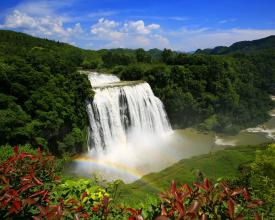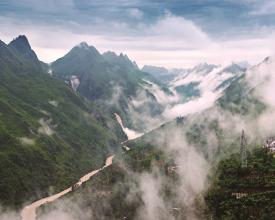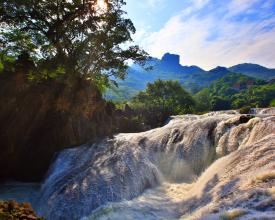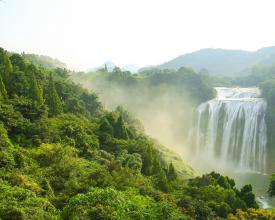
Achieving Effective Water Resources Governance on the Basis of “River Chief System”
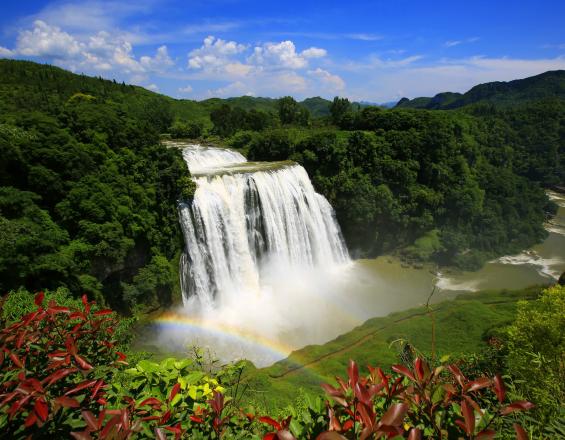
The Huangguoshu Scenic Area were established in 1980, with the Huangguoshu Waterfalls series as the core scenery which are called "Karst Waterfall Museum". In order to protect the aesthetic value of landscape diversity, the water resources ecosystem service value, and the sustainable and harmonious development of man and nature, Guizhou Province formulated the Working Plan for the Full Implementation of the “River Chief System” in 2017, which means that the government leaders at all levels shall serve as the "River Chief", responsible for the management and protection of the corresponding rivers, with a five-level River Chief of province, cities, counties, townships and village. The measures, such as hiring Non-governmental River Chief, establishing Dabang River Basin Management and Protection Plan, etc., have contributed to the poverty alleviation of indigenous people and obtained sufficient water resources, achieving the first and sixth goals of the Sustainable Development Goal 2030.
Contexte
Challenges addressed
- Environment: Since the unique climatic environment and hydrogeological conditions of the Huangguoshu Scenic Area, seasonal water shortages slightly reduce the value of ecosystem services.
- Economic:
- Special funds. Huangguoshu Scenic Area is located in an area with less economic development, and lacks funding resources.
- The development of tourism. Increasing number of tourists bring prosperous economic income but threaten ecological conservation.
- Residents income. Some protection measures will limit the income of residents, such as prohibiting fish farming in the river.
- Society:
- Contradiction between river protection and the economic development and lifestyle of local communities.
- Public's protection awareness is relatively weak. The Huangguoshu Scenic Area is located in a mountainous area. The development of economic and cultural is slightly lagging compared to other areas in China. The local people have not yet universally possessed the idea of ecological civilization.
Emplacement
Traiter
Summary of the process
- Sound design and planning are the basis: The Working Plan for the Full Implementation of the “River Chief System” and The Huangguoshu Scenic Area Master Plan (2018-2035) include special design and planning for the conservation of water landscape and ecosystem, eco-tourism, popular science education and community development. Based on these special plans, all measures are carried out in an orderly manner, with clear goals.
- Sound management mechanism and working mode are the key: According to the plans, the Huangguoshu Scenic Area has adopted a series of management measures based on the “River Chief System”, such as "clearing four chaos" and "one river, one file", etc., to ensure timely and effective treatment of sewage, domestic garbage and so on. In addition, a good plan needs the proper working mode to be realized.
- Complete Legal supervision, monitoring and patrol system is a safeguard: Only by establishing a complete legal supervision, monitoring and patrol system can the River Chiefs at all levels perform their duties effectively and ecological environment continue improved, ensuring the sustainable development of the Huangguoshu Scenic Area and eventually realizing the perpetual harmonious coexistence of man and nature.
Building Blocks
Formulated a specific Working Plan
In 2017, Guizhou Province formulated the Working Plan for the Full Implementation of the “River Chief System", according to the Recommendation on the Full Implementation of the “River Chief System” issued by the General Office of the State Council of the People's Republic of China in December 2016. The Working Plan clarifies the overall requirements and specific work objectives at each stage. The plan emphasizes the five working principles to be adhered to when implementing the “River Chief System”, including i) giving priority to ecology; ii) being led by government and participating in the public; iii) problem-oriented and implementing policies based on actual conditions; iv) overall planning and systematic governance; v) supervision and strict assessment according to law.
Huangguoshu Scenic Area have further refined the work plan, such as establishing Dabang River Basin Management and Protection Plan and Implementation Plan for Law Enforcement Inspections and Popular Science Education, holding several seminars on water supply safety, carrying out a series of work measures on the Dabang River Ecological Day, comprehensive investigating the river ecological status, promulgating the Notice on the Non-governmental River Chief, etc.
Enabling factors
- Set a clear overall objective: to establish a management and protection mechanism with clear responsibilities, orderly coordination, strict supervision, and strong protection.
- Propose specific action plans: 11 specific plans were given, including planning management, water sources protection, sewage prevention, ecological restoration, improvement of laws and regulations, supervision and enforcement, information disclosure and social supervision, etc.
- Set up special funds to ensure the effective development of the “River Chief System”.
Lesson learned
- Fully consider the public and stakeholders: Local residents are very important stakeholders. The tasks of the Working plan should not only emphasize the responsibilities of government departments, but also pay attention to the participation of the general public and stakeholders.
- Establish long-term and short-term goals: The Working Plan clarified the specific goals for 2017-2020, in addition to establishing the long-term goals.
- The Working Plan shall base on the regional background conditions: After considering its provincial situation (that is, there are many small rivers in the mountainous area), Guizhou Province proposed a five-level River Chief System (including province, city, county, township and village) based on the four-level River Chief System (including province, city, county, and township) promoted by the country.
Established the sound management mechanism and working mode
The Guizhou Provincial Government attached great importance to the implementation of the "River Chief System" and established a sound management mechanism. Scientifically and reasonably integrated and distributed the powers, responsibilities and performance evaluation of water-related departments. Innovatively established a five-level “River chief System” and a four-level "Double River Chief System", set up an independent office, held joint meetings, and implemented multi-departmental comprehensive management, etc. Via segmented supervision, management, assessment, and accountability, integrated the execution of local governments at all levels. By the end of 2017, the establishment of the management mechanism of “River Chief System” was basically completed. Since 2018, the Huangguoshu Scenic Area management agency has been responding to the government’s request, using a systematic and comprehensive mode to strengthen overall coordination among departments and industries, and to restore and manage the ecological environment of water resources.
In addition, the hiring of Non-governmental River Chief has promoted the public especially the local communities and indigenous people to participate, so that the government and the public form a good working mode.
Enabling factors
- Adhere to the systematic and comprehensive working mode, forming an effective cooperation mechanism between governments and publication.
- Ensure that each river is contracted to an individual River Chief, with its own record files, to achieve “one river, one file”.
- Make breakthroughs and innovations according to local conditions, and persist in the problem orientation based on the general goals.
- Held regular meetings to summarize experience.
- Form a special plan for popularizing science education to encourage public participation.
Lesson learned
- Fulfill the special funds: Huangguoshu Scenic Area shall carry out fruitful experiments and explorations to provide financial support for promoting the "River Chief System", such as setting up a River Chief reward funding system, introducing social capital investment, promoting the ecological compensation mechanism, expanding the channels for obtaining special funds by market-based means, developing green credit business, etc.
- Strengthen education and publicity to encourage the public to participate more: Local governments at all levels need to further develop and expand the water conservation team by recruiting non-governmental voluntary river supervisors, and hiring river cleaners. The "River Chief System" management mechanism shall basically achieve a sound development, featuring full coverage of the river basin, smooth operation mechanism, and coordinate advancement of multiple subjects.
- Be more proactive: River Chief shall transition from compulsory "responsibility contract" to consciously performing duties to ensure the long-term effectiveness of the river chief system.
Developed a complete Legal supervision,monitoring and patrol system
The Regulations on the Protection of Water Resources of Guizhou Province came into effect on January 1, 2017. It was the first, in China, to propose a full implementation of the “River Chief System” in local regulations, stipulating that the water resources (including lakes and reservoirs) management and conservation in the province shall be fully implemented the “River Chief System” at all levels government.
In addition, the administration has carried out a wide range of monitoring and analysis of water in the Huangguoshu Scenic Area Master Plan (2018-2035). For example, established a water quality monitoring and assessment system for cross-section boundaries, and provide ecological compensation if the water quality outside the boundary meets the assessment requirements. In addition, a strict patrol system was implemented. The local government requires district-level River Chiefs to patrol the river at least once a quarter, town-level River Chiefs to patrol the river at least once a month, and village-level River Chiefs to patrol at least once a week. The administrative departments of each district have to organize patrols at least twice a quarter.
Enabling factors
- Govern water resources in accordance with the law.The decentralization of management functions and departments in the national water resources management and protection mechanism has led to multiple political inconsistencies and low efficiency. We rely on the law to support the River Chief's personal authority to effectively regulate the above-mentioned drawbacks.
- Established a reasonable and effective monitoring system.
- Recorded the operation of the monitoring equipment.
- Implemented the maintenance system of monitoring equipment.
Lesson learned
- Adjust the relationship between "Govern by human" and "Govern by law": The "River Chief System" is a typical model of human governance. The effectiveness of water governance is closely related to individual authority, expertise, and experience. Therefore, it’s necessary to construct a legal system, and to coordinate the relationship between individual and law, to ensure the stability and continuity of the water governance, and to avoid the unfavorable situation of " Individuals leave, policies disappear".
- Supervise with neighboring government departments: The agency should regularly carry out joint law enforcement with neighboring government departments.
- Strengthen the supervision and voice of community residents: In addition to satisfying the public’s right to know, the agency needs to ensure the residents have a voice in the assessment and evaluation of the governance effectiveness as well as substantive supervision.
Impacts
The conservation measures based on the “River Chief System” reflect the relationship between people and water resources. The implementation of this package plan has solved a series of problems, such as improving the water environment, promoting the sustainable development of the ecosystem, enhancing the service value of the ecosystem, and ensuring availability and sustainable management of water and sanitation for all to achieve sixth goal of the SDG 2030. In 2017-2019, the average flow increased from 11.4 m3 / s to 21.3 m3 / s, and the runoff from 0.36 km3 to 0.67 km3.
We adopted a system of "government-enterprise-society" multi-party interaction and joint governance, improved the social’s recognition of the River Chief System, enhanced environmental protection awareness, and increased the enthusiasm of local communities to participate.
In addition, local communities and surrounding residents have also participated as Non-governmental River Chief, voluntary supervisors, and river cleaners. Employment and income sources have increased. In 2016-2019, the GDP has increased from 1.678 billion yuan to 2.466 billion yuan, helping 2500 people escape poverty in 2018 and making outstanding contributions to end poverty and achieve the first goal of SDG 2030.
Beneficiaries
- Indigenous people
- Tourists
- Local administrative agencies
